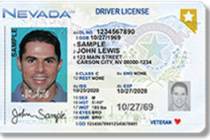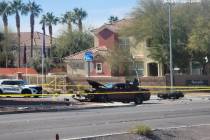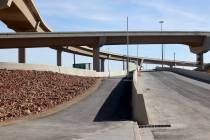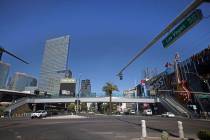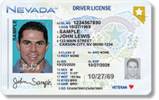Left in dark why pedestrians shun crosswalks
As dusk slipped into darkness during his commute home one late afternoon this past week, the Road Warrior had the topic of today's column - pedestrian safety - brazenly step in front of his headlights: A young man, in his late teens or early 20s, wearing a black hoodie and gray shorts and carrying a skateboard, darted off a median and sprinted across the three-lane street.
The Road Warrior, traveling 35 mph on northbound Rancho Drive, just south of Washington Avenue, had adequate time and distance to slow. No screeching of brakes needed, but the Road Warrior definitely had to slow. As did traffic alongside and behind him.
Good thing he was paying attention, the Road Warrior sighed to himself, as the brief moment of fear soon turned into a thought of journalistic serendipity. In an ideal situation, he would have been able to turn around, catch up to the jaywalker and ask him for this column, "Dude, what were you thinking?"
No such luck. But the example had been presented.
With four pedestrian deaths in the Las Vegas Valley in the opening two weeks of 2013 - three of them clearly the fault of the person on foot - the Road Warrior is left to wonder, "What gives?"
Also wondering are local traffic enforcement officers and their best public advocate, Erin Breen, director of UNLV's Safe Community Partnership Program - a woman so passionate about traffic safety that she frequently goes out to accident scenes in an effort to better understand what happened.
That was the case last weekend, when Breen drove out to Tropicana Avenue to see where a pedestrian passed on using the crosswalk just up the road at Decatur Boulevard to cross seven lanes of traffic in a failed effort to reach ...
"... A dirt lot," Breen said. "I stood there looking at where he was trying to go, and for the life of me I couldn't understand what this person was thinking. It's 11:30 at night, in between two streetlights, in a 45 mph zone and across seven lanes of traffic. And he gets hit in the seventh lane.
"It makes no sense to me. It's such a violent way to have a life end."
Traffic agencies and advocates have taken their concerns about crashes - read: fatalities - to the community through television and radio public service announcements and, yes, newspaper columns as accident numbers in all forms inexplicably jumped in 2012.
There were 42 pedestrian fatalities in Clark County last year, with 40 in the jurisdiction of the Metropolitan Police Department, which was up from 23 in that agency's 2011 total.
Law enforcement has stressed to drivers the importance of maintaining the legal speed, avoiding distractions, not drinking and driving, being on the lookout for pedestrians.
And pedestrians have been told to always use crosswalks; obey traffic signals; wear light-colored or reflective clothing; and avoid distractions while walking, such as texting or wearing headphones that can keep them from hearing dangerous traffic issues before they happen.
Authorities and those who really care, such as Breen, have done everything short of hand-holding pedestrians as they attempt to legally cross the street.
"That's a tough question to answer," officer Marcus Martin, a police spokesman, said when asked why their public pleas for pedestrian safety seem to go unheeded. "We're scratching our heads. We have been for the past two years.
"What we get tired of is the senselessness of it."
In a fast-paced, helter-skelter world where cutting corners is the norm more than the exception, it shouldn't come as a surprise that folks - young, adult, senior; age doesn't matter - look for the shortest distance between two points instead of taking the safest route.
They don't understand the stopping distance - reaction and braking times - required by a driver who comes across an individual making what is known in accident statistics as "pedestrian error."
"Hey, I won't get hit," they say ... until they end up being chalked on a valley street, with Breen standing there trying to understand what they could have been thinking to take such a risk.
"I think some pedestrians get a notion in their head (to cross) and they act on it immediately," Breen said. "Rather than walk to the signal and give themselves the benefit of the doubt, they'd rather take the seven-lane race to death.
"Obviously, we're not doing the right thing to teach them."
And this doesn't take into account the spontaneity and silliness of children, who frequently act impulsively and/or taunt drivers with their actions on sidewalks and medians.
But, really, what more can be done to educate the public? How much louder must the drum be beat to get everyone's attention?
"If you were to go to UNLV right now," Martin said, "you would see students - smart kids and adults - jaywalking, failing to look left or right before crossing, texting and otherwise buried in today's technology.
"It's everywhere, and the sad thing," he added, "is that when it happens, someone might not be coming home to their family or someone who was able to walk the day before now can't."
Does it take showing the bloody gore - or at the very least, the chalked aftermath - of an accident scene to get people to wake up?
"All you have to do is look at the pavement circles. You don't want to make that the last impression you leave in life," Breen said.
"But maybe we have to get that brutal. Maybe we've been soft-pedaling the very real pain of this too much."
Questions and comments should be sent to roadwarrior@reviewjournal.com. Please include your phone number. Follow the Road Warrior on Twitter: @RJroadwarrior.
■ Ramp closures between McCarran International Airport connector and eastbound lanes of the Las Vegas Beltway, from 7 p.m. today to 5 a.m. Monday, for bridge expansion.
■ Lane restrictions and detours on Patrick Lane, between Buffalo Road and Miller Lane, 9 p.m. today through Jan. 20 for flood control improvement.
■ Lane restrictions and detours on Buffalo Road, between Patrick Lane and Post Road, 9 p.m. today through Feb. 23 for flood control improvement.
■ Through-lane reduction on northbound Decatur Boulevard at the Las Vegas Beltway intersection Monday through Jan. 21 for beltway construction.
■ Delays on Jones Boulevard, from U.S. Highway 95 to Sahara Avenue, for widening.
■ Lane restriction on Rainbow Boulevard at Lost Dutchman Drive through Jan. 20 for pavement patching.
■ Detour of eastbound traffic on Sahara Avenue at Boulder Highway through March for storm drain construction project.
■ Bradley Road closed at the Las Vegas Beltway through April 18 for bridge work.
■ Delays on Valley View Boulevard, from U.S. Highway 95 to Desert Inn Road, through June 30 for road widening.
■ F Street, between McWilliams and Wilson avenues, closed for Interstate 15 construction.
GASOLINE PRICES
The average price of gasoline Friday in the Las Vegas Valley was $3.04 per gallon; the state average was $3.11; the national average was $3.27.
LAS VEGAS REVIEW-JOURNAL








